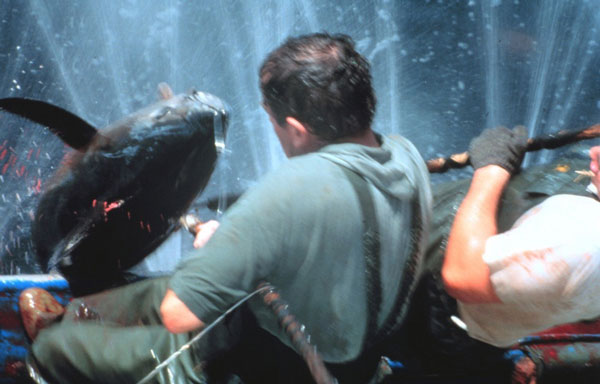Bluefin Tuna Recovery Good
U.S. Quota Stalls at ICCAT

Hauling tuna aboard in the commercial fishery. Pressure from industrial fishing in the Eastern Atlantic and Mediterranean Sea as well as under representation of U.S. quota interests have been ongoing issues at the annual ICCAT meetings. NOAA Photo
Agadir, Morocco - November 19, 2012: The International Commission for the Conservation of Atlantic Tuna (ICCAT) held its 18th Special Meeting in Agadir, Morocco from November 9 to 19 and was attended by 48 member countries, various industry groups as well as environmental non-governmental organizations (ENGO’s).
Major issues on the agenda were the results of the 2012 Atlantic bluefin tuna stock assessments for the eastern Atlantic and Mediterranean Sea and the western Atlantic bluefin tuna populations. The majority of western Atlantic catches are from the United States, Canada and Japan. Other important issues scheduled for discussion included several species of sharks, billfish and the continuing priority of compliance with ICCAT conservation and management measures.
The big news had to do with Atlantic bluefin tuna. The bluefin tuna stock assessment results, presented by the ICCAT scientists, indicated great news for both eastern and western Atlantic bluefin populations. Bluefin tuna stock assessments are conducted every two years by the Standing Committee for Research and Statistics (SCRS), the scientific arm of ICCAT. This prestigious committee is comprised of noted marine scientists from various member-countries.
The 2012 bluefin tuna stock assessment for western Atlantic bluefin tuna was the third stock assessment consistently demonstrating an increase in biomass. This validates that biomass recovery measures first undertaken a few decades ago in the western Atlantic by the United States, Canada and Japan, under highly restrictive fishery management regulations far in excess of ICCAT regulations, has succeeded in bringing western Atlantic bluefin tuna biomass to a healthy state.
Under the most commonly used scientific methodology used by ICCAT scientists, referred to by scientists as the “Low Recruitment Scenario”, western Atlantic bluefin tuna biomass has with the 2012 stock assessment exceeded the all-important target threshold level referred to as Maximum Sustainable Yield (MSY). It is necessary to achieve MSY in order to sustainably harvest bluefin tuna without further diminishing biomass. The 2012 stock assessment conducted by the SCRS scientists state that current biomass is at 145% of the total biomass necessary in order to achieve MSY. The objective of achieving and maintaining MSY is the primary objective of ICCAT regulations as well as the primary policy objective of the US’s National Oceanic and Atmospheric Administration (NOAA), Canada’s Department of Fisheries and Oceans (DFO) and Japan’s Ministry of Agriculture, Forestry and Fisheries.
ICCAT scientists also have good news for the eastern bluefin tuna populations, bluefin that are harvested chiefly in the eastern Atlantic and Mediterranean Sea. The ICCAT stock assessment for the eastern fishery validates a significant recovery trend in biomass after high restrictive regulatory measures were put in place in 2007, having the effect of ending prior overharvesting of bluefin tuna in that region and allowing for the process of recovery of eastern bluefin tuna biomass.
Despite rapid stock improvements, made possible by strict compliance with restrictive quotas and other restrictive regulations relating to minimum length of fish and daily catch limits, the tuna industries from the west Atlantic (U.S., Canada and Japan), in the interest of conservation, collectively opted to request for a precautionary quota of a modest 2,000 metric tons (MT), up from the prior quota level of 1,750 MT set by ICCAT two years ago, but substantially below the scientifically justified level of Maximum Sustainable Yield.
Regrettably, the U.S. government position and objective at the ICCAT meeting in Agadir, set by Dr. Jane Lubchenko, the controversial Secretary of NOAA, was to seek another dramatic reduction in the western quota below the quota level set by ICCAT two years ago. Her position is in contravention of the best scientific advice tendered by ICCAT scientists at this meeting. This move would have further devastated fishing communities all along the eastern seaboard. In setting her policy, Lubchenko went even further then that which was called for by major international environmental groups who advocated for a status quo of quota fixed at 1,750 MT, the quota level fixed at the last ICCAT meeting two years ago.
“In the end, the west Atlantic bluefin tuna quota remained unchanged from the level set two years ago, at 1,750 MT. However, the US’s position was absolutely unnecessary and unwarranted and went completely against the recommendations of ICCAT’s scientists”, said Rich Ruais, Executive Director of the American Bluefin Tuna Association.
– Rich Ruais,
Executive Director, Atlantic Bluefin Tuna Association
